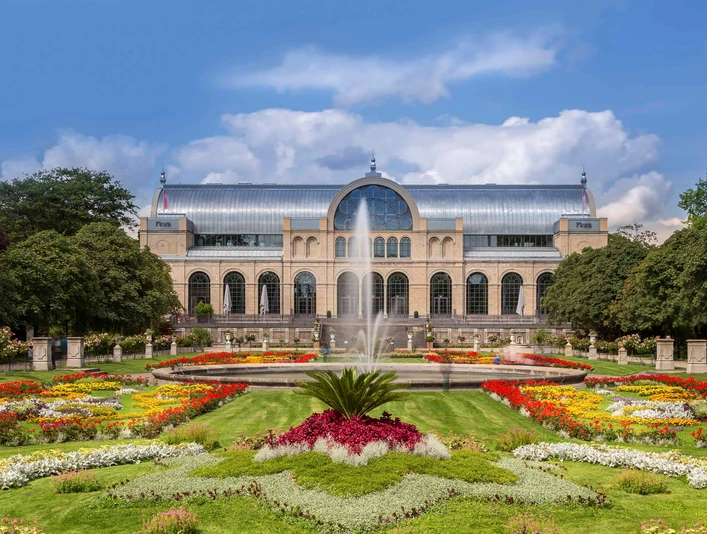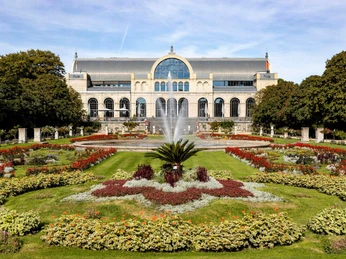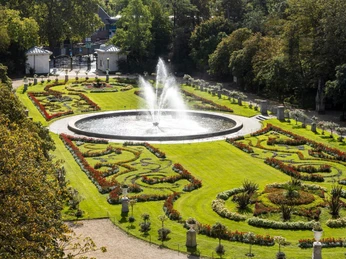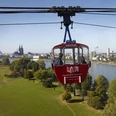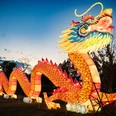The city’s paradise — for plants from all over the world
Ever green, majestic, up to 1,000 years old — the cedar of Lebanon, which the Phoenicians called the queen of all plant species, is a very special tree. One such tree used to stand in the Flora botanic garden in Cologne until it was felled during a stormy night in 2020. It represented just one of the many species of trees, shrubs and other plants that you can view and study today in the Flora. It’s worth a visit during every season and at every time of day, and admission is free of charge.The botanic garden is home to about 12,000 plant species from all over the world on approximately 5.5 hectares of land. It features many different garden styles, such as English landscape, Italian Renaissance and French Baroque gardens. We recommend a stroll along the shaded arcades, past waterfalls, ponds, springs and a fountain. You can also take a look at the alpine plantings, the iris garden or the lily garden and then visit the greenhouses. There’s always something to discover in the Flora. It’s also very relaxing. You can take a break and sit on one of the many benches or in the Flora’s garden café.
The camellia collection in the subtropical greenhouse and outdoors
The camellia collection of the Flora in Cologne is really remarkable. Here visitors can admire more than 500 plants representing 400 species, including original Japanese varieties. Some of the plants in the collection are more than 100 years old. So it’s no surprise that the “Floral Magic from the Far East” exhibition is held here every year between January and April. It has won international awards, and usually attracts about 60,000 visitors. This exhibition is only one of the many events, offers and guided tours you can enjoy at the Flora. For more information take a look at the current event calendar.The Flora has a garden café, a restaurant and is an event location for weddings and other gala events
The garden café “Dank Augusta” (Thanks to Augusta), which is open during the warm months, offers pleasant hours of leisure, picnic bags full of small treats in glass jars and beverages on the terrace.The old “glass palace”, or Palais in the Park, was reopened in 2014 after extensive renovation work. It offers a variety of halls and salons from which you can select exactly the right venue as well as an attractive ambience for events such as weddings, gala events and conferences.
The Flora in Cologne is based on designs created by Peter Joseph Lenné
The botanic garden was created by one of the most influential landscape gardeners of the 19th century, Peter Joseph Lenné. His creations are characterized by varied and surprising visual axes. Pfingstberg, Sanssouci, Pfaueninsel, Tiergarten and many other gardens in Germany bear his signature. His designs for the Flora in Cologne, which was opened to the public in 1864, were one of his last works.The history of the botanic garden on the Alter Stammheimer Weg
Before the Flora was built on Alter Stammheimer Weg in Cologne’s Riehl district, there was an old botanic garden, which was located directly next to the Cathedral. It was cleared away around 1859 to make room for the construction of the city’s main railway station. A prestigious committee of wealthy citizens established a joint stock company in 1862 to finance the construction of a new Flora “botanic garden for ornamentation and pleasure”. The wife of the King of Prussia — Queen Augusta, after whom the garden café was named — became the project’s official patron, and the landscape architect Peter Joseph Lenné was appointed as the project’s consultant.The Flora was opened to the public in 1864. Some 4,000 visitors representing Cologne’s high society came to the opening in hackney carriages, equipages and steamboats. The highlight was the luxurious glass palace, impressively illuminated with Bengal lights, lanterns and little gas flames.
After destruction and neglect, new glamour and highlights
For many years, the Flora was a choice spot for strolling and celebrating — until the cost of maintaining the gardens and the buildings could no longer be covered. The Second World War brought further destruction. The Flora and the tropical greenhouses were rebuilt in the 1950s, but by the 1970s commitment had dwindled and the garden fell into disrepair — until Eugen Moll became the new director and took charge, bringing new glamour to the gardens. He made Lenné’s signature visible once again by implementing historic plans and gradually introduced numerous refurbishments, renovations and new structures.Starting in 2024, there will be another highlight: the new greenhouses with a classic parabolic shape. They will feature discovery trails, surprising insights into tropical environments, a laboratory investigating the evolution of deserts, and much more. A new cedar of Lebanon is also in the plans so that the botanic garden can continue telling the species’ story. All of these aspects make the Flora worth a visit!
Good to know
Eligibility
for Groups
for Class
for families
for individual guests
Suitable for the Elderly
Suitable for Pushchair
Openings
Payment methods
Directions & Parking facilities
tram line 16, stop "Kinderkrankenhaus
Bus 140, bus stop Zoo/Flora
General information
Parking Available
Bus stop available
Accessibility
The paths in the Flora are easy to negotiate with a wheelchair, except for a hill with alpine mountain flora. In addition, there are gradients of more than 8 percent in a greenhouse.
More information
Our recommendations
Nearby
